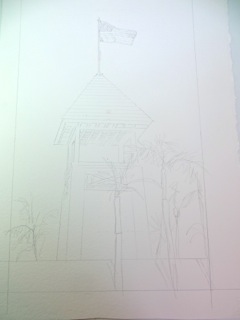I have always loved the challenge of painting the American Flag. The majestic colors, the stars and stripes, and the fluid movement of our flag as it blows in the wind are beautiful. If you are interested in painting the American Flag, or any other flag, using watercolors, perhaps this tutorial gained from many years of experience, including trial and error, will help!
With almost every painting I do I start with a fairly detailed sketch...
Here is my drawing of an American flag waving in the breeze.
After squaring up the four sides of the image I’m going to paint, I tape the edges with masking tape...
...and thoroughly wet the the paper to remove some sizing on the paper (I prefer 300# Arches).
I frequently us a masking fluid on paintings where I want to protect the “white” of the paper. The first step is to thoroughly rub the brush over a bar of soap to prevent the fluid from ruining it!
I pour some masking fluid in the cap and using a small (soaped) brush, carefully block out the area I want to protect.
Using cerulean blue mixed with a little cobalt blue, I mix two puddles of color.
The one on the right as a little more water and more cerulean (for the lower sky).
I always use a little scrap paper to test the color I have blended.
I have painted the sky around (and over!) the masked in flag shapes.
After the sky is thoroughly dry I use a rubber cement pickup to remove the masking fluid.
Quite often there maybe a some residual blue color you’ve used around the masked area….
...so, use an old brush’s bristles that you have cut down to about 1/8” to “scrub out” the unwanted color…(a great way to “correct” and remove unwanted, small areas of paint!).
Since this flag is just part of the painting (and not a closeup) it’s not necessary to paint
each of the 50 stars, but to merely indicate them. The first step is to paint the part of
the flag that is in shadow. I use a light mixture of Winsor blue plus a touch of brown
madder to create a soft blue (same color I use to indicate snow shadows).
Next I paint the “royal blue” color using cobalt blue mixed with some Winsor blue.
Now it’s time for the red stripes. Cadmium Red is a little “too red” so I mix it with some
Alizaron Crimson and maybe a little Brown Madder (but not much). The goal to to mix
a deep red (not too warm or “orangey”).
Cardinal rule… know your complementary colors! Whenever you want to make a color
appear darker (in shadow, etc.) use a dab of it’s complement color! In this case I added
just a touch of Sap Green (Winsor Green would do, but be careful it’s a potent color and
more on the vibrant, cool side, so a little goes a long way!) I used this darker color on
the stripes that are in shadow. This step really helps give the flag definition.
The rest of the painting will be finished soon, but here is the finished flag. Viewed from this distance the small white “specks” in the blue rectangle give the appearance of stars. Looks like a flag waving in the breeze. Just what I hoped to achieve!
Please share the flags you paint!
Linda Roberts
PS: Go on a treasure hunt this Flag Day Saturday! Find any print or poster that includes a flag and receive 50% of that piece at lindarobertsgallery.com.

















